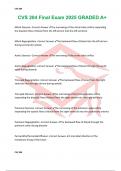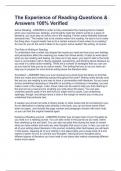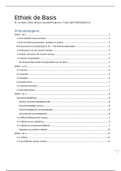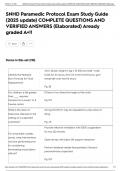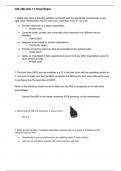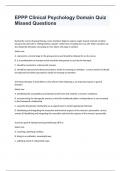Gerontology les 1 10/11/2020 Koerts
Normal aging part 1
If you have a normal development and decline, the estimation is that you are improving very rapidly
up until you are about 20 years, then it very slowly starts to decline. So, we reach the peak at 20-30
and then end up in a plateau, so you reach the peak early and then stay on the peak for a while and
then slowly start deterioration. So, in your 40s you are still partly in the plateau. This is considered as
normal development and decline. Not everybody develops and declines normally. One thing that
might happen (line B) is that exposure in early life (e.g. to diseases) may leave imprints on structures
or function of body systems. It can happen that you don’t reach the same level of functioning that
normal people reach. It could be that the decline is in a similar way as normal people, but they start
at a lower point due to the early life exposure. A final option is that
exposure acting in mid or in later life accelerates age-related decline. This
means that you have normal development, you reach the peak, but then
you have an abnormal (faster) decline (line C). These are three options but
there are many different life course trajectories possible, there are massive
individual differences in aging.
The population pyramid of 2014 shows us that there are fewer births. You can see the baby boom
generation; these people were born after the second world war. There are also changes in the top of
the pyramid, the number of people who reach the age of 70 years and older is further increased, so
the life expectancy is increasing. For the future they predict that there are still fewer births, and
more and more people reach a high age. As a society. we have to prepare for that situation because
then we are faced with more and more people suffering from dementia etc.
If you look at the proportion of people that are aged 60 years and older, you see that over time the
proportion of people aged 60 years or older is increased. In more developed regions this proportion
is increased a lot, in the less and least developed countries there is also a sharp increase, but it is way
less compared to the more developed regions.
How come this proportion is on the increase? There are two factors:
1. The life expectancy at birth is increasing over time (people become older)
2. The number of children born per women is decreasing
Both of these aspects cause that the proportion of people aged 60 years and older is increasing. This
also means that the proportion of people developing dementia is increasing.
Chronological age measured in units of time (months or years) that have elapsed since birth.
Biological age where people stand relative to the number of years they will live. This is very
speculative; nobody knows how long you will live. But still you can look into a body’s organ system
and physical appearance and determine the biological age.
Functional age person’s competence in carrying out specific tasks. This is a way of looking at aging
where you compare yourself to chronological age peers. It can be that someone is rather good at a
certain task and from that point of view looks younger in terms of functional age than their peers.
Psychological age refers to how well a person adapts to changing conditions. The better you
adapt, the younger you are considered in terms of psychological age.
Social age views held by most members of society about what individuals in a particular
chronological age group should do and how they should behave.
There are many different perspectives on the aging process:
- Normative aging focused on what is considered a usual, normal, or average outcome
- Successful aging focused on what is considered an ideal rather than average outcome
, - Positive aging focused on the ability to find happiness and well-being even if you are faced
with physical and/or psychological challenges.
There are two theoretical models of aging:
1. The selective optimization with compensation model of aging
2. The ecological model of aging
1 The selective optimization with compensation model of aging
This model says that individuals engage in adaptation throughout their lifes. They are capable of
learning and changing and calling upon extra (reserve) capacity that they might not need to use
under ordinary circumstances (but that you might need to use in situations out of the ordinary).
You start in certain conditions; you have a certain life development and a certain amount of reserve
capacity and you deal with certain losses in specific functions in a certain way. These are the
antecedent conditions. There are several processes involved, namely selection,
optimization and compensation. The combination of the antecedent
conditions (factors that you have to deal with) and the processes result in a
certain outcome which is a reduced and transformed but effective life.
The processes:
- Selection: is a strategy of concentrating your efforts on domains in which effective
functioning is most likely to remain high (this means that if you have an overview of all your
strengths and weaknesses, that you focus very much on your strengths and maybe your
strengths can compensate for your weaknesses). This is why selection is very important.
- Optimization: is a strategy of focusing on behaviors that maximize not only the quantity but
also the quality of life.
- Compensation: refers to substituting new strategies when losses occur (this is about
changing, adaptation and dealing with certain challenges that you are faced with).
This model says that even though you are confronted during aging with many different challenges,
e.g. physical changes or certain conditions, we deal with it by selecting our strengths, by optimization
(focusing on a good quality of life) and by compensating for it.
2 The ecological model of aging
This model looks into the interaction between environmental presses or challenges that you deal
with and your competences. If you have an optimal interaction between environmental presses and
challenges and your competences, then according to this model you are in the
zone of maximum performance potential. This is a zone where you usually feel
good, you deal with the challenges you are faced with. There are also areas
where there is either high pressure and low competence or high competence
and low pressure, in these situations you often don’t feel great. Your behaviour
is maladaptive.
This model says that in the end, aging is an interaction between a person’s competence and the
environment, this results in some level of adaptation. This is measured in a person’s emotional well-
being (how well do you feel when you are faced with certain challenges). Someone’s competence can
be measured in many different ways, it can be physical competence, sensory competence, cognitive
competence but also your social capabilities. In general, studies have demonstrated that people with
a high competence can adapt positively to a wider range of environmental press than a person with
low competence.
,Questions that we can ask in the context of aging are, why does aging occur? What determines how
long people live? What are all these biological changes that we are confronted with? Biological
changes in this context is defined as decremental physical changes (both structural and functional)
that develop with the passage of time and that eventually end with death. What are these biological
changes and what determines them?
Biology of aging this is a very gradual and cumulative process, with a peak in early adulthood.
After early adulthood we know that there is a decline, the rate of decline differs strongly between
individuals. Aging is not by definition a very negative process, not the majority, but even so most
older adults are neither helpless nor dependent.
You can wonder if all the biological changes that we go through are a consequence of the aging
process or are they the consequence of a disease? You should be aware of the fact that aging in the
absence of any disease is rare. The likelihood of many disease increases with age. The main risk
factor of dementia is age. Also, aging affects the consequences of disease when it occurs, i.e. aging
process and disease process interact.
Morbidity refers to illness and disease. Mortality refers to death. These two terms are related:
- Illness and disease can result in death
- Death is often preceded by illness and disease
- But, morbidity does not necessarily result in mortality
Life span is the maximum longevity, or extreme upper limit of time, that members of a species can
live. For humans this maximum is approximately 120 years. This number doesn’t change much. What
is changing is the number of people that become very old. The number of centenarians is increasing a
lot. There is a big difference between males and females, much more females reach a higher age
compared to males. But, in both groups there is an increase in the number of centenarians.
Life expectancy is the average number of years that individuals in a particular birth cohort can be
expected to live. This has increased over time. So, life span has stayed the same over time, but life
expectancy has increased over time. Life expectancy is affected by factors such as level of nutrition,
sanitary conditions and medical care. The phenomenon that more and more people approach the
max. life span is called the compression of mortality.
Theories of biology of aging, there are basically two different categories of these theories:
Some theories biological aging occurs within the organism regardless of outside forces.
Other theories biological aging is influenced by our environment and daily habits and the way we
cope with life’s challenges.
This basically means that theories that focus on primary aging, these theories say that aging is an
unavoidable (inevitable) biological process that affects all members of a species (universal). It is set in
motion early in life and progresses gradually over time, there are individual differences in
progression rate. This is intrinsic and determined by factors within the organism (no environmental
pressure, it is based in our genetic make-up).
The secondary aging theories, these theories say that aging is experienced by most, but not
necessarily all members of a species (it is neither inevitable nor universal). These theories say that
aging is a result from hostile environmental influences, e.g. disease, disuse (e.g. lack of exercise),
abuse (e.g. smoking).
Another term for these theories that are related to primary aging is programmed theories. There are
three different theories, namely the time clock theory, the immune theory and the evolutionary
, theory. The programmed theories consider aging to be under the control of a genetically based
blueprint, related to primary aging. They are contrasted with the so-called stochastic theories, the
error theory, wear and tear theory and the stress theory. These theories focus on random damage to
our vital systems that occurs with the process of aging, related to secondary aging.
Programmed theories of aging
- Time clock theory suggests that cells from a human infant doubled approximately 50
times, whereas cells from a mouse (max. life span of 3 years) doubled 10-15 times. So, they
think that the number of times that cells double has something to do with your life span. This
resulted in the theory that says that life span is controlled by genetically determined time
clock at cellular level. The more times your cells can divide, the longer your life span. This is
supported by many different studies, e.g. by the finding that cells from infants and young
children divide more times than cells from older adults. It is also supported by studies that
did research to down syndrome and progeria, both conditions showed a lower life
expectancy. The studies showed that the number of times that the cells divide is lower in
these groups of people. It is thought that the time clock theory is very strongly related to our
telomeres that we find in our chromosomes, they are the protective cap at the tail ends of
our chromosomes. These tail ends shorten over time and eventually cell division stops. So,
this is the time clock theory, we have a time clock in our genes according to this theory.
- Immune theory we all have an immune system that defends our body against invasion of
foreign substances by producing antibodies. According to this theory, our immune system is
programmed in such a way to maintain its efficiency for a certain amount of time, after which
it starts to decline. This can happen due to insufficient antibodies, or we might have inferior
antibodies: mistakenly attack and destroy normal cells. This theory is linked to cancer and is
related to primary aging.
- Evolutionary theory this theory says that members of a species are genetically
programmed to bear and rear their young. Once they reproduce and raise their offspring to
independence, they have fulfilled their service in perpetuating the species. It depends on the
levels of energy an organism still has left, how long you will live after that. Once the excess of
energy is used up, you become more susceptible to diseases. This theory is supported by
studies conducted in fruit flies, if fruit flies are forced to delay reproduction, they live longer
compared to fruit flies that reproduced early. We are genetically programmed in such a way
to reproduce, as soon as we have done this we are basically done according to this theory.
Stochastic theories of aging, these secondary theories of aging focus on random damage to our vital
systems that occurs with the process of aging. An overarching approach of these theories is that, as
damage accumulates, we cease to function efficiently and eventually life becomes impossible to
sustain. These theories are strongly supported by studies that have been conducted in identical
twins, they have the same genetic makeup, but they have different rates of aging – they rarely live
exactly the same amount of time. This must mean that it is not only our genetic makeup that is
determining the process of aging, our environment also has an influence on aging.
- Error theory suggests that errors occur at cellular level resulting in the production of
faulty molecules, this results from organism’s metabolic processes and as a result of
exposure to environmental factors (e.g. radiation). Our cells have a repair mechanism but
may not keep up with damage created by faulty molecules. Over time, unrepaired damage
builds up resulting into metabolic failure which has an impact on aging.
- Wear and tear theory we start life with a fixed amount of physiological energy. If we
expend it quickly, aging begins early and proceeds rapidly. A question that then comes up is,
can we retard aging by conserving energy? Unfortunately, there is not a lot of support for
this theory. Studies show that people who work in physically strenuous jobs do not show
signs of aging any earlier than those who work in less physically demanding jobs.
Normal aging part 1
If you have a normal development and decline, the estimation is that you are improving very rapidly
up until you are about 20 years, then it very slowly starts to decline. So, we reach the peak at 20-30
and then end up in a plateau, so you reach the peak early and then stay on the peak for a while and
then slowly start deterioration. So, in your 40s you are still partly in the plateau. This is considered as
normal development and decline. Not everybody develops and declines normally. One thing that
might happen (line B) is that exposure in early life (e.g. to diseases) may leave imprints on structures
or function of body systems. It can happen that you don’t reach the same level of functioning that
normal people reach. It could be that the decline is in a similar way as normal people, but they start
at a lower point due to the early life exposure. A final option is that
exposure acting in mid or in later life accelerates age-related decline. This
means that you have normal development, you reach the peak, but then
you have an abnormal (faster) decline (line C). These are three options but
there are many different life course trajectories possible, there are massive
individual differences in aging.
The population pyramid of 2014 shows us that there are fewer births. You can see the baby boom
generation; these people were born after the second world war. There are also changes in the top of
the pyramid, the number of people who reach the age of 70 years and older is further increased, so
the life expectancy is increasing. For the future they predict that there are still fewer births, and
more and more people reach a high age. As a society. we have to prepare for that situation because
then we are faced with more and more people suffering from dementia etc.
If you look at the proportion of people that are aged 60 years and older, you see that over time the
proportion of people aged 60 years or older is increased. In more developed regions this proportion
is increased a lot, in the less and least developed countries there is also a sharp increase, but it is way
less compared to the more developed regions.
How come this proportion is on the increase? There are two factors:
1. The life expectancy at birth is increasing over time (people become older)
2. The number of children born per women is decreasing
Both of these aspects cause that the proportion of people aged 60 years and older is increasing. This
also means that the proportion of people developing dementia is increasing.
Chronological age measured in units of time (months or years) that have elapsed since birth.
Biological age where people stand relative to the number of years they will live. This is very
speculative; nobody knows how long you will live. But still you can look into a body’s organ system
and physical appearance and determine the biological age.
Functional age person’s competence in carrying out specific tasks. This is a way of looking at aging
where you compare yourself to chronological age peers. It can be that someone is rather good at a
certain task and from that point of view looks younger in terms of functional age than their peers.
Psychological age refers to how well a person adapts to changing conditions. The better you
adapt, the younger you are considered in terms of psychological age.
Social age views held by most members of society about what individuals in a particular
chronological age group should do and how they should behave.
There are many different perspectives on the aging process:
- Normative aging focused on what is considered a usual, normal, or average outcome
- Successful aging focused on what is considered an ideal rather than average outcome
, - Positive aging focused on the ability to find happiness and well-being even if you are faced
with physical and/or psychological challenges.
There are two theoretical models of aging:
1. The selective optimization with compensation model of aging
2. The ecological model of aging
1 The selective optimization with compensation model of aging
This model says that individuals engage in adaptation throughout their lifes. They are capable of
learning and changing and calling upon extra (reserve) capacity that they might not need to use
under ordinary circumstances (but that you might need to use in situations out of the ordinary).
You start in certain conditions; you have a certain life development and a certain amount of reserve
capacity and you deal with certain losses in specific functions in a certain way. These are the
antecedent conditions. There are several processes involved, namely selection,
optimization and compensation. The combination of the antecedent
conditions (factors that you have to deal with) and the processes result in a
certain outcome which is a reduced and transformed but effective life.
The processes:
- Selection: is a strategy of concentrating your efforts on domains in which effective
functioning is most likely to remain high (this means that if you have an overview of all your
strengths and weaknesses, that you focus very much on your strengths and maybe your
strengths can compensate for your weaknesses). This is why selection is very important.
- Optimization: is a strategy of focusing on behaviors that maximize not only the quantity but
also the quality of life.
- Compensation: refers to substituting new strategies when losses occur (this is about
changing, adaptation and dealing with certain challenges that you are faced with).
This model says that even though you are confronted during aging with many different challenges,
e.g. physical changes or certain conditions, we deal with it by selecting our strengths, by optimization
(focusing on a good quality of life) and by compensating for it.
2 The ecological model of aging
This model looks into the interaction between environmental presses or challenges that you deal
with and your competences. If you have an optimal interaction between environmental presses and
challenges and your competences, then according to this model you are in the
zone of maximum performance potential. This is a zone where you usually feel
good, you deal with the challenges you are faced with. There are also areas
where there is either high pressure and low competence or high competence
and low pressure, in these situations you often don’t feel great. Your behaviour
is maladaptive.
This model says that in the end, aging is an interaction between a person’s competence and the
environment, this results in some level of adaptation. This is measured in a person’s emotional well-
being (how well do you feel when you are faced with certain challenges). Someone’s competence can
be measured in many different ways, it can be physical competence, sensory competence, cognitive
competence but also your social capabilities. In general, studies have demonstrated that people with
a high competence can adapt positively to a wider range of environmental press than a person with
low competence.
,Questions that we can ask in the context of aging are, why does aging occur? What determines how
long people live? What are all these biological changes that we are confronted with? Biological
changes in this context is defined as decremental physical changes (both structural and functional)
that develop with the passage of time and that eventually end with death. What are these biological
changes and what determines them?
Biology of aging this is a very gradual and cumulative process, with a peak in early adulthood.
After early adulthood we know that there is a decline, the rate of decline differs strongly between
individuals. Aging is not by definition a very negative process, not the majority, but even so most
older adults are neither helpless nor dependent.
You can wonder if all the biological changes that we go through are a consequence of the aging
process or are they the consequence of a disease? You should be aware of the fact that aging in the
absence of any disease is rare. The likelihood of many disease increases with age. The main risk
factor of dementia is age. Also, aging affects the consequences of disease when it occurs, i.e. aging
process and disease process interact.
Morbidity refers to illness and disease. Mortality refers to death. These two terms are related:
- Illness and disease can result in death
- Death is often preceded by illness and disease
- But, morbidity does not necessarily result in mortality
Life span is the maximum longevity, or extreme upper limit of time, that members of a species can
live. For humans this maximum is approximately 120 years. This number doesn’t change much. What
is changing is the number of people that become very old. The number of centenarians is increasing a
lot. There is a big difference between males and females, much more females reach a higher age
compared to males. But, in both groups there is an increase in the number of centenarians.
Life expectancy is the average number of years that individuals in a particular birth cohort can be
expected to live. This has increased over time. So, life span has stayed the same over time, but life
expectancy has increased over time. Life expectancy is affected by factors such as level of nutrition,
sanitary conditions and medical care. The phenomenon that more and more people approach the
max. life span is called the compression of mortality.
Theories of biology of aging, there are basically two different categories of these theories:
Some theories biological aging occurs within the organism regardless of outside forces.
Other theories biological aging is influenced by our environment and daily habits and the way we
cope with life’s challenges.
This basically means that theories that focus on primary aging, these theories say that aging is an
unavoidable (inevitable) biological process that affects all members of a species (universal). It is set in
motion early in life and progresses gradually over time, there are individual differences in
progression rate. This is intrinsic and determined by factors within the organism (no environmental
pressure, it is based in our genetic make-up).
The secondary aging theories, these theories say that aging is experienced by most, but not
necessarily all members of a species (it is neither inevitable nor universal). These theories say that
aging is a result from hostile environmental influences, e.g. disease, disuse (e.g. lack of exercise),
abuse (e.g. smoking).
Another term for these theories that are related to primary aging is programmed theories. There are
three different theories, namely the time clock theory, the immune theory and the evolutionary
, theory. The programmed theories consider aging to be under the control of a genetically based
blueprint, related to primary aging. They are contrasted with the so-called stochastic theories, the
error theory, wear and tear theory and the stress theory. These theories focus on random damage to
our vital systems that occurs with the process of aging, related to secondary aging.
Programmed theories of aging
- Time clock theory suggests that cells from a human infant doubled approximately 50
times, whereas cells from a mouse (max. life span of 3 years) doubled 10-15 times. So, they
think that the number of times that cells double has something to do with your life span. This
resulted in the theory that says that life span is controlled by genetically determined time
clock at cellular level. The more times your cells can divide, the longer your life span. This is
supported by many different studies, e.g. by the finding that cells from infants and young
children divide more times than cells from older adults. It is also supported by studies that
did research to down syndrome and progeria, both conditions showed a lower life
expectancy. The studies showed that the number of times that the cells divide is lower in
these groups of people. It is thought that the time clock theory is very strongly related to our
telomeres that we find in our chromosomes, they are the protective cap at the tail ends of
our chromosomes. These tail ends shorten over time and eventually cell division stops. So,
this is the time clock theory, we have a time clock in our genes according to this theory.
- Immune theory we all have an immune system that defends our body against invasion of
foreign substances by producing antibodies. According to this theory, our immune system is
programmed in such a way to maintain its efficiency for a certain amount of time, after which
it starts to decline. This can happen due to insufficient antibodies, or we might have inferior
antibodies: mistakenly attack and destroy normal cells. This theory is linked to cancer and is
related to primary aging.
- Evolutionary theory this theory says that members of a species are genetically
programmed to bear and rear their young. Once they reproduce and raise their offspring to
independence, they have fulfilled their service in perpetuating the species. It depends on the
levels of energy an organism still has left, how long you will live after that. Once the excess of
energy is used up, you become more susceptible to diseases. This theory is supported by
studies conducted in fruit flies, if fruit flies are forced to delay reproduction, they live longer
compared to fruit flies that reproduced early. We are genetically programmed in such a way
to reproduce, as soon as we have done this we are basically done according to this theory.
Stochastic theories of aging, these secondary theories of aging focus on random damage to our vital
systems that occurs with the process of aging. An overarching approach of these theories is that, as
damage accumulates, we cease to function efficiently and eventually life becomes impossible to
sustain. These theories are strongly supported by studies that have been conducted in identical
twins, they have the same genetic makeup, but they have different rates of aging – they rarely live
exactly the same amount of time. This must mean that it is not only our genetic makeup that is
determining the process of aging, our environment also has an influence on aging.
- Error theory suggests that errors occur at cellular level resulting in the production of
faulty molecules, this results from organism’s metabolic processes and as a result of
exposure to environmental factors (e.g. radiation). Our cells have a repair mechanism but
may not keep up with damage created by faulty molecules. Over time, unrepaired damage
builds up resulting into metabolic failure which has an impact on aging.
- Wear and tear theory we start life with a fixed amount of physiological energy. If we
expend it quickly, aging begins early and proceeds rapidly. A question that then comes up is,
can we retard aging by conserving energy? Unfortunately, there is not a lot of support for
this theory. Studies show that people who work in physically strenuous jobs do not show
signs of aging any earlier than those who work in less physically demanding jobs.

